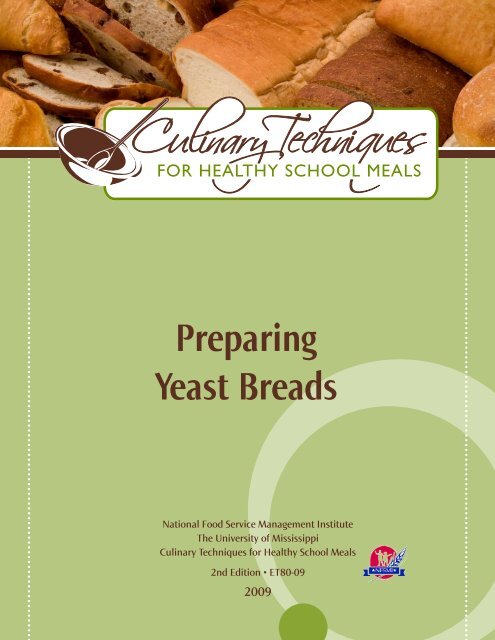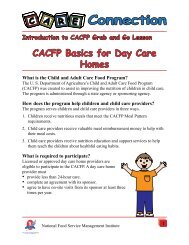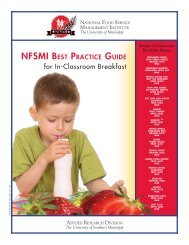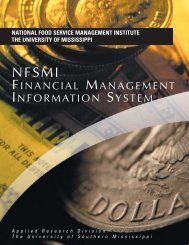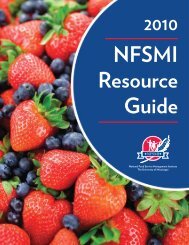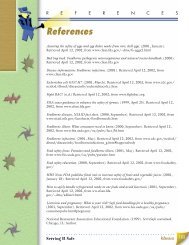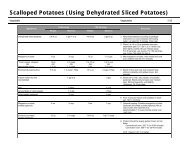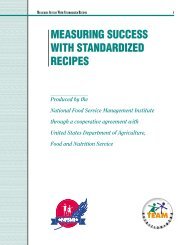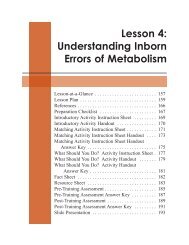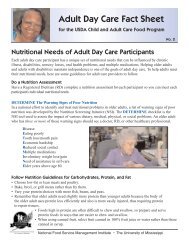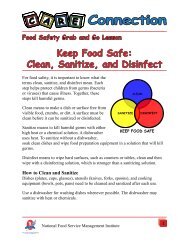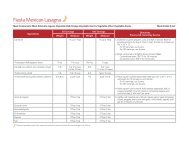Preparing Yeast Breads - National Food Service Management Institute
Preparing Yeast Breads - National Food Service Management Institute
Preparing Yeast Breads - National Food Service Management Institute
You also want an ePaper? Increase the reach of your titles
YUMPU automatically turns print PDFs into web optimized ePapers that Google loves.
<strong>Preparing</strong><strong>Yeast</strong> <strong>Breads</strong><strong>National</strong> <strong>Food</strong> <strong>Service</strong> <strong>Management</strong> <strong>Institute</strong>The University of MississippiCulinary Techniques for Healthy School Meals2nd Edition • ET80-092009
This project has been funded at least in part with Federal funds from the U.S. Departmentof Agriculture, <strong>Food</strong> and Nutrition <strong>Service</strong> through an agreement with the <strong>National</strong> <strong>Food</strong><strong>Service</strong> <strong>Management</strong> <strong>Institute</strong> at The University of Mississippi. The contents of thispublication do not necessarily reflect the views or policies of the U.S. Department ofAgriculture, nor does mention of trade names, commercial products, or organizationsimply endorsement by the U.S. government.The University of Mississippi is an EEO/TitleVI/Title IX/Section 504/ADA/ADEA Employer.© 2009, <strong>National</strong> <strong>Food</strong> <strong>Service</strong> <strong>Management</strong> <strong>Institute</strong>, The University of MississippiExcept as provided below, you may freely use the text and information contained in thisdocument for non-profit, educational use providing the following credit is included.Suggested Reference Citation:<strong>National</strong> <strong>Food</strong> <strong>Service</strong> <strong>Management</strong> <strong>Institute</strong>. (2009). Culinary techniques for healthyschool meals (2nd ed.). University, MS: Author.The photographs and images in this document may be owned by third parties and usedby the University of Mississippi under a licensing agreement. The University cannot,therefore, grant permission to use these images. For more information, please contactnfsmi@olemiss.edu.Culinary Techniques for Healthy School Meals<strong>Preparing</strong> <strong>Yeast</strong> <strong>Breads</strong> i
<strong>National</strong> <strong>Food</strong> <strong>Service</strong> <strong>Management</strong> <strong>Institute</strong>The University of Mississippi<strong>Preparing</strong> <strong>Yeast</strong> <strong>Breads</strong>Building the Future Through Child NutritionThe <strong>National</strong> <strong>Food</strong> <strong>Service</strong> <strong>Management</strong> <strong>Institute</strong> was authorized by Congress in 1989and established in 1990 at The University of Mississippi in Oxford. The <strong>Institute</strong> operatesunder a grant agreement with the U.S. Department of Agriculture, <strong>Food</strong> and Nutrition<strong>Service</strong>.PURPOSEThe purpose of the <strong>National</strong> <strong>Food</strong> <strong>Service</strong> <strong>Management</strong> <strong>Institute</strong> is to improve theoperation of child nutrition programs through research, education and training, andinformation dissemination. The Administrative Offices and Divisions of Information<strong>Service</strong>s and Education and Training are located in Oxford. The Division of AppliedResearch is located at The University of Southern Mississippi in Hattiesburg.MISSIONThe mission of the <strong>National</strong> <strong>Food</strong> <strong>Service</strong> <strong>Management</strong> <strong>Institute</strong> is to provide informationand services that promote the continuous improvement of child nutrition programs.VISIONThe vision of the <strong>National</strong> <strong>Food</strong> <strong>Service</strong> <strong>Management</strong> <strong>Institute</strong> is to be the leader in providingeducation, research, and resources to promote excellence in child nutrition programs.CONTACT INFORMATIONHeadquartersThe University of MississippiPhone: 800-321-3054Fax: 800-321-3061www.nfsmi.orgEducation and Training DivisionApplied Research DivisionInformation <strong>Service</strong>s DivisionThe University of Southern MississippiThe University of Mississippi 118 College Drive #100776 Jeanette Phillips Drive Hattiesburg, MS 39406-0001P.O. Drawer 188 Phone: 601-266-5773University, MS 38677-0188 Fax: 888-262-9631Culinary Techniques for Healthy School Meals<strong>Preparing</strong> <strong>Yeast</strong> <strong>Breads</strong> ii
AcknowledgmentsSECOND EDITION WRITTEN BYCatharine Powers, MS, RD, LDCulinary Nutrition Associates, LLCVIDEO PRODUCTION BYThe Culinary <strong>Institute</strong> of AmericaHyde Park, NY 12538GRAPHIC DESIGN BYTami PetittoMedina, OHACKNOWLEDGEMENTSSincere appreciation is expressed to all individuals who contributed their time andexpertise to the development of the first edition of Culinary Techniques for HealthySchool Meals. The first edition was developed and funded by a USDA Team NutritionGrant awarded to the states of Mississippi, Florida, and Kentucky. Additional fundingand expertise was provided by the states of Alabama, Georgia, Louisiana, North Carolina,South Carolina, and Tennessee. A special thanks to Doris Schneider of Mississippi,Patricia Craig Jenkins, and Dr. Josephine Martin of the <strong>National</strong> <strong>Food</strong> <strong>Service</strong> <strong>Management</strong><strong>Institute</strong>, and Lumina Training Associates for their original work.PROJECT COORDINATORCatharine Powers, MS, RD, LDCulinary Nutrition Associates, LLCEXECUTIVE DIRECTORCharlotte B. Oakley, PhD, RD, FADACulinary Techniques for Healthy School Meals<strong>Preparing</strong> <strong>Yeast</strong> <strong>Breads</strong> iii
Table of ContentsPage<strong>Preparing</strong> <strong>Yeast</strong> <strong>Breads</strong> .. . . . . . . . . . . . . . . . . . . . . . . . . . . . . . . . . . . . . . . . . . . . . . . . 2Important Terms .. . . . . . . . . . . . . . . . . . . . . . . . . . . . . . . . . . . . . . . . . . . . . . . . . . . . . 3Mise en Place.. . . . . . . . . . . . . . . . . . . . . . . . . . . . . . . . . . . . . . . . . . . . . . . . . . . . . . . . 4<strong>Yeast</strong> <strong>Breads</strong> and Healthy School Meals . . . . . . . . . . . . . . . . . . . . . . . . . . . . . . . . 5 - 6Culinary Principles .. . . . . . . . . . . . . . . . . . . . . . . . . . . . . . . . . . . . . . . . . . . . . . . . 7 - 9What Happened to the <strong>Yeast</strong> Bread?. . . . . . . . . . . . . . . . . . . . . . . . . . . . . . . . . . . . . 10Culinary Technique: The Straight-Dough Method for <strong>Yeast</strong> <strong>Breads</strong>. . . . . . . . . . . . 11Quality Standards .. . . . . . . . . . . . . . . . . . . . . . . . . . . . . . . . . . . . . . . . . . . . . . . . . . . 12Quality Score Card for <strong>Yeast</strong> <strong>Breads</strong>.. . . . . . . . . . . . . . . . . . . . . . . . . . . . . . . . . . . . . 13Culinary Application and Practice Activity. . . . . . . . . . . . . . . . . . . . . . . . . . . . . . . . 14Culinary Practice Score Card for <strong>Yeast</strong> <strong>Breads</strong> . . . . . . . . . . . . . . . . . . . . . . . . . . . . . 15References .. . . . . . . . . . . . . . . . . . . . . . . . . . . . . . . . . . . . . . . . . . . . . . . . . . . . . . . . . 16Culinary Techniques for Healthy School Meals<strong>Preparing</strong> <strong>Yeast</strong> <strong>Breads</strong> 1
<strong>Preparing</strong> <strong>Yeast</strong> <strong>Breads</strong>ObjectivesImprove the quality of whole-grain yeast breads served to students.Improve the variety of whole-grain yeast breads served to students.Improve the appeal of whole-grain yeast breads served to students.Main Ideas in This Lesson• <strong>Yeast</strong> breads play an important role in a healthy diet.• Each ingredient in a yeast bread recipe has a special job to do. Follow the recipe exactly.The culinary technique, straight-dough method for yeast breads, is a step-by-step wayto prepare breads that meet quality standards.• All yeast breads should be evaluated using the Quality Score Card before placement onthe serving line.Preparation for LearningReview the list of recipes with each Culinary Technique. The recipes are available at:U.S. Department of Agriculture, <strong>Food</strong> and Nutrition <strong>Service</strong>, & <strong>National</strong> <strong>Food</strong> <strong>Service</strong><strong>Management</strong> <strong>Institute</strong>. (2005). USDA recipes for child care. University, MS: Author.Available online at http://www.nfsmi.orgU.S. Department of Agriculture, <strong>Food</strong> and Nutrition <strong>Service</strong>, & <strong>National</strong> <strong>Food</strong> <strong>Service</strong><strong>Management</strong> <strong>Institute</strong>. (2006). USDA recipes for schools. University, MS: Author.Available online at http://www.nfsmi.orgPractice or ApplicationPrepare one or more of the recipes listed with one of the Culinary Techniques.Additional SuggestionsUse the training kit, On the Road to Professional <strong>Food</strong> Preparation, to demonstratecorrect measuring and weighing of ingredients.Culinary Techniques for Healthy School Meals<strong>Preparing</strong> <strong>Yeast</strong> <strong>Breads</strong> 2
Important TermsWheat Flour TermsEnrichedFlour supplemented with iron and fourB-vitamins (thiamine, niacin, riboflavin,and folate) and may be with calcium, toreplace some of the nutrients lost duringprocessing.FortifiedImplies that something is added to a productthat makes its nutritional status higher thanthe product made from unprocessed rawmaterials.Pre-sifted flourSifted at the mill, making it unnecessaryto sift before measuring.Bromated flourLargely discontinued in the United States.Ascorbic acid is now being added tostrengthen the flour for bread doughs.BleachedRefers to flour that has been bleachedchemically to whiten or improve the bakingqualities. No change occurs in the nutritionalvalue of the flour and no harmfulchemical residues remain. Bleaching speedsup the natural lightening and maturingof flour.Unbleached flourAged and bleached naturally by oxygen inthe air. It is more golden in color and maynot have the consistency in baking qualitiesthat bleached flour does. Unbleached ispreferred for yeast breads because bleachingaffects gluten strength.Patent flour, bleached or unbleachedThe highest grade of flour. It is lower in ashand protein with good color. Market-wise,it is considered the highest in value andmostly used by bakers.CulinaryRelating to the kitchen or cooking. An example of useis to describe food preparation skills as culinary skills.Culinary TechniqueA step-by-step food preparation method. The culinarytechnique discussed in this lesson is the straightdoughmethod for yeast breads.GlutenThe protein in flour. Gluten strands are formed as theresult of kneading the flour and water and they givethe structure to a bread product.Just-In-Time PreparationThis term is used throughout the lessons to meanpreparing a menu item in small enough amounts sothat it will be at its peak of quality when placed on theserving line. This preparation schedule avoids holdingany food for a long time. Other terms that mean thesame thing are batch cooking and cooking to the line.Mise en Place (meez-un-plahss)A French term used by chefs and other food professionalsto describe all the different things that haveto be done to get ready up to the point of cooking.Translated, it means put in place. It includes all theget ready steps in food preparation such as using therecipe to assemble the equipment needed and gettingingredients ready to combine.ProofingThe final rising period before baking for yeast doughsthat have been shaped.ScalingA baking term that means measuring and weighingingredients. Dry ingredients should be weighed. Ifscales are not available, measure dry ingredients withdry measuring utensils. Liquid ingredients should bemeasure using liquid measuring utensils.SlashingUsing a sharp knife to make several cuts diagonallyacross the bread loaf before it is baked. This is usuallydone for breads that have a hard crust, such as Frenchbread. Also called docking.<strong>Preparing</strong> <strong>Yeast</strong> <strong>Breads</strong> 3
Mise en PlaceTypes of FloursAll-purpose flour – White flour milled from hard wheats or a blend ofhard and soft wheats. It gives the best results for many kinds of products,including some yeast breads, quick breads, cakes, cookies, pastries, andnoodles. It is usually enriched and may be bleached or unbleached. Proteinvaries from 8–11%.Bread flour – White flour that is a blend of hard, high-protein wheats andhas greater gluten strength and protein content than all-purpose flour. It isunbleached and in some cases conditioned with ascorbic acid. Protein variesfrom 12–14%.Cake flour – A fine-textured, silky flour milled from soft wheats with lowprotein content. It is used to make cakes, cookies, crackers, quick breads,and some types of pastry. Cake flour has a greater percentage of starch andless protein, which keeps cakes and pastries tender and delicate. Proteinvaries from 7–9%.Self-rising flour – Also referred to as phosphated flour, it is a convenienceproduct made by adding salt and leavening to all-purpose flour. It is commonlyused in biscuits and other quick breads, but is not recommended foryeast breads. One cup of self-rising flour contains 1 1/2 teaspoons bakingpowder and 1/2 teaspoon salt. Self-rising can be substituted for all-purposeflour by reducing salt and baking powder according to these proportions.Pastry flour – Has properties intermediate between those of all-purposeand cake flours. It is usually milled from soft wheat for pastry-making,but can be used for cookies, cakes, crackers, and similar products. It differsfrom hard wheat flour in that it has a finer texture and lighter consistency.Protein varies from 8–9%.Semolina – The coarsely ground endosperm of durum, a hard springwheat with a high-gluten content and golden color. It is hard, granular,and resembles sugar. Semolina is usually enriched and is used to makecouscous and pasta products such as spaghetti, vermicelli, macaroni, andlasagna noodles. Except for some specialty products, breads are seldommade with semolina.Whole wheat flour and graham flour – Used interchangeably; nutrientvalues differ minimally. Either grinding the whole wheat kernel or recombiningthe white flour, germ, and bran that have been separated duringmilling produces them. Their only differences may be in coarseness andprotein content. Insoluble fiber content is higher than in white flours.Gluten flour – Usually milled from spring wheat and has a high protein(40–45%), low-starch content. It is mixed with other non-wheat or lowproteinwheat flours to produce a stronger dough structure. Gluten flourimproves baking quality and produces high-protein gluten bread.Grains are divided into2 subgroups, whole grainsand refined grains.Whole grains contain theentire grain kernel - thebran, germ, and endosperm.Examples:• whole wheat flour• bulgur (cracked wheat)• oatmeal• whole cornmeal• brown riceRefined grains have beenmilled, a process that removesthe bran and germ.This is done to give grainsa finer texture and improvetheir shelf life, but it alsoremoves dietary fiber, iron,and many B vitamins. Someexamples of refined grainproducts:• white flour• degermed cornmeal• white bread• white riceMost refined grains are enriched.This means certain Bvitamins (thiamin, riboflavin,niacin, folic acid) and iron areadded back after processing.Fiber is not added back toenriched grains. Check theingredient list on refinedgrain products to make surethat the word “enriched” isincluded in the grain name.Some food products aremade from mixtures of wholegrains and refined grains.Culinary Techniques for Healthy School Meals<strong>Preparing</strong> <strong>Yeast</strong> <strong>Breads</strong> 4
<strong>Yeast</strong> <strong>Breads</strong> and Healthy School MealsDietary guidelines recommend that half ofour grains should be whole grains. Schoolbakedyeast rolls are an excellent way toincrease whole grains in students’ diets.Grains provide important vitamins andminerals without providing large quantitiesof fat. Most breads and cereals are naturallylow in fat. Only when butter, margarine,mayonnaise, or heavy sauces are added doesthis group become high in fat. Whole-grainbreads and cereals are especially importantbecause they provide a good source ofdietary fiber.Menu-Planning Practices for HealthySchool Meals• Plan a variety of breads and breadalternates such as whole wheat breads,multigrain breads and brown rice.• Offer school-baked bread, replacingmost of the white flour with wholewheat flour. Begin slowly by replacing1/3 of the white flour withwhole wheat flour and graduallyincreasing until the whole wheatpart is greater than 50%. Moreleavening ingredients and liquidsmay be required as the percentage ofwhole-grain flour increases.Purchasing Practices for HealthySchool Meals• When purchasing oils and fats to usein preparing yeast breads, purchasepolyunsaturated and/ormonounsaturated oils, such as canola,corn, cottonseed, olive, peanut,safflower, soybeans, or sunflower oils.• Do not purchase or use lard.• Avoid hydrogenated oils/fats, whichmay contain trans fats.Children should eat 4–7 ounce equivalentsof grains each day with at leasthalf of those grains whole grains.According to MyPyramid:• consuming foods rich in fiber, such aswhole grains, as part of a healthy diet,reduces the risk of coronary heart disease.• consuming foods rich in fiber, such aswhole grains, as part of a healthy diet,may reduce constipation.• eating at least 3 ounce equivalents a day ofwhole grains may help with weight management.Culinary Techniques for Healthy School Meals<strong>Preparing</strong> <strong>Yeast</strong> <strong>Breads</strong> 5
<strong>Yeast</strong> <strong>Breads</strong> and Healthy School Meals, continuedNutrients in GrainsGrains are important sources of many nutrients,including dietary fiber, several B vitamins(thiamin, riboflavin, niacin, and folate), andminerals (iron, magnesium, and selenium).• Dietary fiber from whole grains, as part ofan overall healthy diet, helps reduce bloodcholesterol levels and may lower risk ofheart disease. Fiber is important for properbowel function. It helps reduce constipationand diverticulosis. Fiber-containing foodssuch as whole grains help provide a feelingof fullness with fewer calories. Whole grainsare good sources of dietary fiber; most refined(processed) grains contain little fiber.• The B vitamins (thiamin, riboflavin, niacin,and folate) play a key role in metabolism– they help the body release energy fromprotein, fat, and carbohydrates. The B vitaminsare also essential for a healthy nervoussystem. Many refined grains are enrichedwith these B vitamins.• Folate, another B vitamin, helps the bodyform red blood cells.• Iron is used to carry oxygen in the blood.Many teenage girls and women in theirchildbearing years have iron-deficiencyanemia. They should eat foods high inheme-iron (meats) or eat other iron containingfoods along with foods rich invitamin C, which can improve absorptionof non-heme iron. Whole and enrichedrefined grain products are major sources ofnon-heme iron in American diets.• Whole grains are sources of magnesiumand selenium. Magnesium is a mineralused in building bones and releasing energyfrom muscles. Selenium protects cells fromoxidation. It is also important for a healthyimmune system.Menus for school meals should provide studentswith a selection of whole-grain bread, pastas,rice, and cereals. This lesson is about preparingyeast breads, one of the most popular foodsserved in any school cafeteria. The smell ofschool-baked yeast breads gives an importantmessage to students. The message is that schoolmeals are made with pride by professionalswho can prepare real foods from scratch.There are many excellent recipes that includeinteresting ways to present yeast breads. Someexamples of yeast breads include pizza crusts,flatbreads, and breadsticks, a student favorite.Culinary Techniques for Healthy School Meals<strong>Preparing</strong> <strong>Yeast</strong> <strong>Breads</strong> 6
Culinary PrinciplesBasic Principles of <strong>Preparing</strong> <strong>Yeast</strong> <strong>Breads</strong>The straight dough method is a culinary techniqueused by professional bakers the worldover. Using it the right way with a good recipeinsures quality yeast bread that can be servedwith pride.<strong>Yeast</strong> bread recipes, like all other recipes, arebased on principles of food production. Principlesare rules that apply in many differentsituations. So even though there are thousandsof recipes for different kinds of yeast breads,they are all based on the same basic principlesof combining ingredients. Understanding thesebasic principles of preparing yeast breads isimportant because it explains the importanceof each ingredient and why certain steps of arecipe must be completed.Scaling is a baking term that means measuringand weighing ingredients. Dry ingredientsshould be weighed. Liquid ingredients can bemeasured by volume. Good quality yeast breadbegins scaling the ingredients exactly for theamounts shown in the recipe.Weighing and measuring ingredients the rightway is the difference between success and failurein many recipes. To review the right way toweigh or measure ingredients, refer to On TheRoad To Professional <strong>Food</strong> Preparation, availableat www.nfsmi.org.IngredientsEach ingredient in a yeast bread recipe has a specialjob to do. Following is an explanation of the functionof the typical ingredients in a yeast bread recipe.Ingredient 1: FlourPurpose in the recipeFlour is the main ingredient and provides thestructure for the bread. Gluten, the proteinin flour, is developed when it is mixed withliquid. The gluten develops into long, elasticstrands that form pockets and capture gases asthe dough rises. Different kinds of flour havedifferent amounts of gluten. Bread flour (hardwheatflour) has more gluten than pastry orcake flour (soft-wheat flour). A greater amountof gluten in bread flour helps form strongerstructures in the product which is appropriatefor bread. Cake or pastry flour gives a moredelicate structure that is desirable for a cakeor pastry. A soft flour holds together whensqueezed in the hand, but hard-wheat flourcrumbles. All-purpose flour, the kind usuallyused in schools, is a mixture of both hardwheatand soft-wheat flour.Types of flourTypes of flour include bread flour, all-purposeflour, self-rising flour, cake flour, whole wheatflour, whole wheat blends, and rye flour (20%rye flour). Most whole wheat and rye breadscontain some all-purpose or bread flour togive enough gluten since whole wheat and ryeflours by themselves do not contain enoughgluten.How can the flour affect the qualityof the bread?Using the same roll or bread recipe, the followingthings can happen because of the flour:Poor Volume – The bread does not rise asmuch as it should. The gluten in the flour wasnot developed enough (bread was not kneadedadequately) or the amount of gluten was notenough to give structure. An example is whenwhole wheat flour is substituted for too muchof the all-purpose or bread flour in a recipe.Coarse Texture – The bread has a coursecrumb. This can happen because the recipe wasnot followed and too little flour was added.Since the gluten in the flour gives the structure,too little gluten means that not enough elasticstrands of gluten would be developed for a finecrumb. A course texture can also be causedfrom under kneading.Culinary Techniques for Healthy School Meals<strong>Preparing</strong> <strong>Yeast</strong> <strong>Breads</strong> 7
Culinary Principles, continuedIngredient 2: <strong>Yeast</strong>Purpose in the recipe<strong>Yeast</strong> is a living organism that produces carbondioxidegas that enables bread to rise. In orderfor the yeast to work, it must be alive. Packagesof yeast show a use by date that means theyeast should be alive up to that date. Rememberto use yeast by the date on the package anddon’t risk ruining an excellent recipe by usingold yeast.Types of yeast:1. Active dry yeast – Free-flowing in foilbags or vacuum sealed. This yeast must berehydrated in water at 95 °–100 °F.2. Instant Dry yeast – Vacuum sealed foilbricks. This yeast is mixed with dryingredients or added directly to dough.3. Compressed <strong>Yeast</strong> – Block form or bulk.<strong>Yeast</strong> bread recipes give specific instructionsfor use.In school kitchens, instant dry yeast is oftenused. Instant dry yeast can be combined withall the other dry ingredients before the warmliquid is added. Because the instant dry yeastis protected by the flour in the mixture, thetemperature of the liquid can be as high as120 °F when it is added to the dry ingredients.Follow the recipe exactly when combining theyeast with warm liquid because liquid that istoo hot will kill the yeast cells and liquid that istoo cold will mean the yeast cells cannot grow.In either case, the yeast will not make the breadrise.ReminderTwo items to check before combining ingredients:• To yield a quality product, the yeast should bechecked to be sure it is not old and out of date.• The temperature of the water should bechecked before adding to the dry ingredients.How can the yeast affect the qualityof the bread?Heavy texture of the bread:• Lack of proper mixing to distribute theyeast cells• Lack of time for the yeast to grow• Old or dead yeast• Too little yeast (poor volume)Bread with too great a volume results whentoo much yeast is used. A yeasty taste is causedby allowing bread to rise too long so that toomuch yeast grows.Ingredient 3: LiquidPurpose of liquid in the recipeThe liquid in a yeast bread recipe is needed tomix all the ingredients together and to moistenthe gluten so it can be developed into strandsby kneading.Types of Liquids:1. Water2. MilkHow can the liquid affect the qualityof the bread?The liquid must be carefully measured andshould be at the right temperature for the kind ofyeast to be used. A liquid that is above 138 °Fwill kill the yeast; at temperatures below 34 °Fthe yeast will not grow. The ideal temperaturefor the liquid in yeast bread is affected bythe kind of yeast that will be used. Follow therecipe exactly for the temperature of the liquid.Use a stem-type thermometer to check theactual temperature of the liquid before it isadded to the yeast or dry ingredient mixture.Water has an effect on yeast bread dough. Softwater produces sticky doughs while hard waterslows the fermentation of the dough. Warm waterhelps the dough reach the right temperaturequicker than using cold.Culinary Techniques for Healthy School Meals<strong>Preparing</strong> <strong>Yeast</strong> <strong>Breads</strong> 8
Culinary Culinary Principles, Principles continuedIngredient 4: SugarPurpose in the RecipeSugar in a yeast bread recipe provides food forthe yeast. In proper amounts, it speeds the actionof the yeast, helps the bread to brown, andcontributes to tenderness. Recipes describe theright kind of sugar to use. Honey, molasses, andsorghum provide more sweetening power thanwhite sugar, give a different flavor, make thebread darker and improve the keeping qualities.How can the sugar affect the qualityof the bread?A yeast bread gets some sugar from the actionof the yeast on the flour and someis included in the recipe. In a sweetbread recipe, such as cinnamonrolls, the additional sugar causesthe yeast to grow slower so theproofing time must be longer.Ingredient 5: SaltPurpose in the recipeEven though yeast bread recipesdo not contain much salt, thesmall amount used has severalimportant roles to play.• Salt adds flavor.• Salt controls the yeast development andincreases the time required for bread to rise.• Salt has a firming effect on gluten structure.Salt in yeast bread recipes should not be omittedor the amount changed from the recipe.How can the salt affect the quality of the bread?When there is too little salt, yeast grows toofast and the gluten structure will not supportthe bread. Too little salt causes the bread tofall and makes the texture too dense or heavy.When salt is added to the mixture is important.It should be added with the flour and other dryingredients, never to the yeast and water mixturesince it can retard the growth of the yeast.A flat flavor occurs when salt is omitted.Ingredient 6: FatPurpose in the recipeThe small amount of fat called for in yeastbread recipes should never be reduced. Fatprovides flavor and tenderness in yeast breads.It helps the crust to brown and it gives thebread keeping quality. <strong>Yeast</strong> bread recipesmay call for oil, margarine, orbutter. Use the kind of fatspecified in the recipe.Butter and margarineboth have 20% moistureso oil cannot besubstituted in thesame amount.Butter or margarineshould not be added tothe top of rolls beforethey are served. Addingthis extra fat is not necessaryfor a good taste and itadds too much fat to the bread.How can the fat affect the quality ofthe bread?Too little fat can cause the bread to be toughand lack flavor. Since fat affects the keepingquality, a recipe with too little fat means thebread will become stale quickly.Culinary Techniques for Healthy School Meals<strong>Preparing</strong> <strong>Yeast</strong> <strong>Breads</strong> 9
What Happened to the <strong>Yeast</strong> Bread?<strong>Yeast</strong> Bread ProblemWhat Could Have Happened to Cause it?Too much volume • Too much yeast • Too little salt• Oven temperature too low • Overproofed• Wrong kind of flour for • Too much dough for thethe bread recipebaking panToo little volume • Too little yeast or old yeast • Too much salt• Dough chilled• Wrong kind of flour for• Over- or underproofed the bread recipe• Not enough dough in • Kneaded too much orthe baking pannot enoughPale color • Not enough sugar • Oven temperature too low• Overfermented dough • Dried crust formed before bakingDark color • Too much sugar • Too much milk• Dough temperature too low • Oven temperature too high• Baked too longCracked crust • Overmixed • Dough too stiff• Improperly shaped • Cooled too fast• Top of hard-crust bread not • Dried crust formed duringslashed properly before baking proofingBlisters on crust • Too much liquid • Improperly shapedCoarse texture • Not enough flour • Slack dough• Underkneaded• Proofed too long or at too• Temperature of dough out high a temperatureof mixer too highLarge holes in bread • Too much yeast • Overkneaded• Inadequate punch downHeavy texture • Underkneaded • Too cool proofing temperature• Not enough yeast• Poor distribution of ingredients• Too short proofing time • <strong>Yeast</strong> partially killed• Too much dough in the by hot liquidbaking panCrumbly, dry • Too stiff dough • Underkneaded• Dough proofed too long • Oven temperature too lowPoor flavor • Flat flavor - too little salt • <strong>Yeast</strong>y flavor - too long• Sour flavor - too long proofing period or proofingproofing or poortemperature too warmquality ingredientsCulinary Techniques for Healthy School Meals<strong>Preparing</strong> <strong>Yeast</strong> <strong>Breads</strong> 10
The Straight-Dough Method for <strong>Yeast</strong> <strong>Breads</strong>1. Scale ingredients.Dry ingredients should be weighed and liquid ingredientsshould be measured.2. Mix.Combine all ingredients and mix with an upright mixeror a vertical mixer.3. Knead.Using the dough hook, increase the speed and kneaduntil smooth.4. Ferment.Shape the dough into a round ball and leave in themixing bowl in a warm place to rise.5. Punch down the dough.Pull the dough up on all sides, fold over the center,pressing down and turning over in the bowl.6. Bench and rest.Leave the dough for a short timeto give it time to recover frompunching down.7. Portion dough.Divide dough into portions asdescribed in the recipe.8. Round and shape.Round and shape the dough asdescribed in the recipe.9. Bench proof.Allow the shaped dough to rise until itis doubled in size and springs back slowlywhen punched with a finger10. Bake.Bake according to the time and temperature given in therecipe. Loaf bread will sound hollow when tapped lightly onthe bottom.11. Cool and store.Cool yeast bread at room temperature after it is removedfrom the pan. Do not refrigerate.Try these USDA Recipesthat include thisCulinary TechniqueCinnamon Rolls.. . . . . . . B-8Italian Bread .. . . . . . . . B-11Pizza Crust . . . . . . . . . . B-14Rolls (<strong>Yeast</strong>) .. . . . . . . . . B-16White Bread.. . . . . . . . . B-19Stromboli.. . . . . . . . . . . . F-6Culinary Techniques for Healthy School Meals<strong>Preparing</strong> <strong>Yeast</strong> <strong>Breads</strong> 11
Quality StandardsBefore any food is placed on the serving line, it should be evaluated using the QualityScore Card. The quality standards shown on the score card can only be reached when ayeast bread recipe is followed exactly. The manager and the foodservice assistant whoprepared the food should make the determination whether the food product meets thestandards on the Quality Score Card. If the decision is made that the food does not meetthe quality standards, do the following things:1. Substitute another bread product on the serving line. Follow the school districtprocedure for menu substitutions.2. Use the bread another way, if possible, to avoid wasting the food. Someexamples of ways yeast bread can be used include making salad croutons, breadcrumbs, breading, and bread pudding.3. Determine what happened during preparation that caused the poor quality andmake plans to correct the preparation next time.Culinary Techniques for Healthy School Meals<strong>Preparing</strong> <strong>Yeast</strong> <strong>Breads</strong> 12
Quality Score Card for <strong>Yeast</strong> <strong>Breads</strong>Date: ______________Name of Menu Item:______________________________________________________Proudly Prepared by ___________________________________________________________________________Quality Scored by _____________________________________________________________________________Directions: When the food is ready to serve, use this Quality Score Card to evaluate the quality. Mark YESwhen the food meets the standard and NO when it does not. Mark NA (Not Applicable) when a specificquality standard does not apply to the food being evaluated. Use the COMMENTS section to explain why a fooddoes not meet a standard.Remember, if a food does not meet the quality standards, it should not be placed on the serving line.Quality Standard Yes No NA CommentsAppearanceColor of crust is golden brown. m m mColor is smooth, free from air bubbles. m m mSlices of bread are uniform in size. m m mRolls are uniform in size. m m mColor of the interior is creamy white (or lightbrown, depending on the type of flour used). m m mTexture or ConsistencyCrust is tender (French bread or other hardcrust breads should have a crisp crust). m m mGrain is moist. m m mGrain is fine and even (free from holes). m m mBread is fresh, not dried out or stale. m m mCrumb is elastic. m m mFlavor and SeasoningBread is fresh-tasting with a nut-like flavor. m m mBread is free from foreign flavors such asrancid fat or sour taste. m m m<strong>Service</strong> TemperatureNo lower than 60 °F m m mCulinary Techniques for Healthy School Meals <strong>Preparing</strong> <strong>Yeast</strong> <strong>Breads</strong> 13
Culinary Application and Practice ActivityDescription of the ActivityCulinary practice is an activity designed to give foodservice assistants an opportunityto practice preparing yeast breads using the Culinary Technique – The Straight-DoughMethod for <strong>Yeast</strong> <strong>Breads</strong>. This practice should be completed within 10 days after thelesson. Use the Culinary Practice Score Card for the activity.1. <strong>Food</strong>service assistants may work as partners or individually, depending on thedirections from the manager. One partner should be someone who cooks and theother, someone who has other responsibilities. Both foodservice assistants shouldwork together to complete the Culinary Practice.2. The manager and foodservice assistants should discuss the culinary practice forpreparing yeast breads. Make a note of the date the Culinary Practice should becompleted and discussed with the manager.3. The manager will approve the recipe to be used for the practice. The recipeshould use the straight-dough method. Review the steps of this culinarytechnique:• Culinary Technique: The Straight-Dough Method for <strong>Yeast</strong> <strong>Breads</strong>4. The manager and foodservice assistants whoprepared the product will evaluate theproduct before it is placed on theserving line. Use the Quality ScoreCard for <strong>Yeast</strong> <strong>Breads</strong>.Culinary Techniques for Healthy School Meals<strong>Preparing</strong> <strong>Yeast</strong> <strong>Breads</strong> 14
Culinary Practice Score Score Card Card for <strong>Yeast</strong> <strong>Breads</strong>Name(s): _ ____________________________________________________________________________________(This practice activity may be completed individually or with a partner. The manager will make this assignment atthe end of the lesson.)Purpose: The purpose of the activity is to practice <strong>Preparing</strong> <strong>Yeast</strong> <strong>Breads</strong>.Culinary Technique: (Identify the culinary technique that you will use. Refer to the previous pages for a descriptionof each technique.)_____________________________________________________________________________________________Name of the Recipe: ___________________________________________________________________________Date for Production: ___________________________________________________________________________Directions: The manager and foodservice assistant(s) will select a recipe for yeast bread that includesone of the culinary techniques described in this lesson.Check YES or NO when each step is completed.YesNoPlan food production for just-in-time service.Did you plan food production for just-in-time service? m mReview the Quality Score Card and the recipe.Did you review the recipe so you are familiar with the ingredients, equipment, and directions? m mDid you review the Quality Score Card so you will know how the finished product shouldlook and taste? m mOrganize equipment and ingredients.Did you assemble all the equipment needed? m mDid you assemble all of the ingredients needed? m mUse the right culinary technique.Did you use the culinary technique correctly? m mDeliver a quality product.Did you use the Quality Score Card to evaluate the product? m mDid you review the product with the manager? m mDiscuss the following questions with the manager before serving.How can the appearance of the food be improved?How can the flavor or taste of the food be improved?How can the texture and tenderness of the food be improved?How can the service temperature of the food be improved?The manager’s signature indicates this practice has been completed satisfactorily. The manager should keep this onfile or submit it to the central office to document the completion of the lesson.Name of Manager: __________________________________________Date Signed: _ _____________________Culinary Techniques for Healthy School Meals <strong>Preparing</strong> <strong>Yeast</strong> <strong>Breads</strong> 15
ReferencesCulinary <strong>Institute</strong> of America. (2002). The professional chef (pp. 875-896).New York: John Wiley & Sons, Inc.Molt, M. (2006). <strong>Food</strong> for fifty (pp.264-266, 299-316). New Jersey: Pearson Education, Inc.<strong>National</strong> <strong>Food</strong> <strong>Service</strong> <strong>Management</strong> <strong>Institute</strong>. (2005). Healthy cuisine for kids.University, MS: Author.U.S. Department of Agriculture, <strong>Food</strong> and Nutrition <strong>Service</strong>. (n.d.). Inside the pyramid.Washington, DC: Author.U.S. Department of Agriculture, <strong>Food</strong> and Nutrition <strong>Service</strong>. (n.d.). Quality food for quality meals.Washington, DC: Author.U.S. Department of Agriculture, <strong>Food</strong> and Nutrition <strong>Service</strong>. (2004). Fruits and vegetablesgalore: Helping kids eat more. Washington, DC: Author.U.S. Department of Agriculture, <strong>Food</strong> and Nutrition <strong>Service</strong>. (2007). HealthierUS schoolchallenge: Recognizing nutrition excellence in schools. Washington, DC: Author.U.S. Department of Agriculture, <strong>Food</strong> and Nutrition <strong>Service</strong>. (2007, January). The road toSMI success: A guide for school food service directors. Washington, DC: Author.U.S. Department of Agriculture, <strong>Food</strong> and Nutrition <strong>Service</strong>, & <strong>National</strong> <strong>Food</strong> <strong>Service</strong><strong>Management</strong> <strong>Institute</strong>. (1996). Choice plus: A food and ingredient reference guide.Washington, DC: Author.U.S. Department of Agriculture, <strong>Food</strong> and Nutrition <strong>Service</strong>, & <strong>National</strong> <strong>Food</strong> <strong>Service</strong><strong>Management</strong> <strong>Institute</strong>. (2005). USDA recipes for child care. University, MS: Author.U.S. Department of Agriculture, <strong>Food</strong> and Nutrition <strong>Service</strong>, & <strong>National</strong> <strong>Food</strong> <strong>Service</strong><strong>Management</strong> <strong>Institute</strong>. (2006). USDA recipes for schools. University, MS: Author.U.S. Department of Health and Human <strong>Service</strong>s, & U.S. Department of Agriculture. (2005).Dietary guidelines for americans 2005 (6th ed.). Washington, DC: Author.Wheat <strong>Food</strong>s Council. (2005). Grains of truth about wheat flour. Colorado: Author.Culinary Techniques for Healthy School Meals<strong>Preparing</strong> <strong>Yeast</strong> <strong>Breads</strong> 16
<strong>National</strong> <strong>Food</strong> <strong>Service</strong> <strong>Management</strong> <strong>Institute</strong>The University of MississippiP.O. Drawer 188University, MS 38677-0188www.nfsmi.org©2009 <strong>National</strong> <strong>Food</strong> <strong>Service</strong> <strong>Management</strong> <strong>Institute</strong>The University of Mississippi


